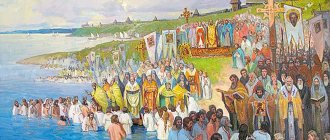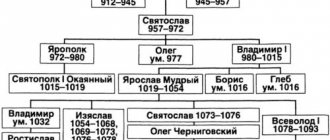Year of adoption of Christianity in Rus'
The date of the establishment of Christianity in Rus' worries many historians. Despite lengthy discussions, it has not yet been possible to reach a consensus.
When did the adoption of Christianity occur in Rus'?
Many people will answer this question with confidence. The information is included in the school history curriculum.
The adoption of Christianity is traditionally associated with the name of Prince Vladimir and even indicates the exact date of the event - 988.
Other researchers are still inclined to believe that this happened a little earlier and call the year 880.
How was it?
In general, the adoption of Christianity is a long process. It could not pass in one day or even a year.
It is generally accepted that the first follower of this religion was Princess Olga, and only then the teaching began to spread throughout the territory of Rus'.
Written sources, in particular “The Tale of Bygone Years,” indicate that it was Vladimir who was the first to think about the need for a single God for his subjects. This way it would be easier to unite the people, evoke their patriotic feelings and establish at least some kind of order.
The story of how Vladimir “chose” the desired god and faith is described in detail. Allah and Islam were rejected because Muslims were forbidden to drink intoxicating drinks. And without this, the prince could not imagine life in Rus'. The ruler also did not like the Catholic teaching, and the prince did not even listen to the Khazars, since, according to their religion, they did not have their own land.
Then the prince decided to attend services of representatives of all faiths. The Byzantine temple struck him with its luxury, and this played an important role in his decision. Rus' was to become Orthodox.
How did historians determine the date?
Historians relied on written sources to establish the date:
- "The Tale of Bygone Years."
- "Byzantine Chronicles".
The chronicle describes the process in detail, while in Greek documents the baptism of Rus' is mentioned only in passing. But both there and there, the same date is indicated: 6496. But the Tale of Bygone Years says that in this year the prince baptized the people of Kiev, and Byzantine chronicles indicate that Vladimir himself was baptized in this year.
This is the first discrepancy that historians point out.
However, other researchers even say that Rus' was baptized during the time of Vasily I, and he ruled before Vladimir. This happened after the Russians attacked Constantinople (860).
Byzantium, in order to protect itself, pursued a special policy in order to consolidate friendly relations. The result was the spread of Christian teaching throughout the territory of Rus'.
During these same years the following were baptized:
- Prince Askold;
- Prince Dir;
- boyars close to them.
Several other settlements also adopted Christianity.
Why do they give different dates for the adoption of Christianity?
In order not to get completely confused, historians began to distinguish the First period of the Baptism of Rus' and the main one, which is indicated in Russian textbooks.
One way or another, the exact date of baptism has not been established. The year 988 is most likely named in connection with the mass baptism of Kiev residents. It was such a large-scale event that it was reflected in the chronicles of those times, literature, and art. While individual rituals were not recorded. And if there were, then the information about this was contradictory and so rare that it was no longer possible to confirm it with a second source.
Therefore, although different dates are named, the year 988 is considered the year of the baptism of Rus', and the merits of this are attributed to Prince Vladimir. But when naming this date, we should not forget that the Slavs began to convert to the faith much earlier. And after 988 there were still villages in which paganism flourished. Thus, indicating the specific year in which Rus' adopted Christianity is not entirely correct.
Baptism of Kyiv and foundation of the church
The decision to adopt Christianity was made and implemented in 988. The baptism of Rus' by Prince Vladimir began in Kyiv, and the Patriarch of Constantinople sent his clergy there to conduct the ceremony. While baptism was taking place in the waters of the Dnieper River, Vladimir prayed to God to send faith to his people and strength to fight their enemies.
Despite the help of Byzantine priests, Kyiv needed to found its own church. A number of historians support the version that the first Russian Church was dependent on the Bulgarian one, however, this version is poorly supported by documentation.
And also the opinions of researchers regarding the first clergy were divided. It is traditionally considered that the first metropolitan was Michael the Syrian, who founded several of the first monasteries. But other names are also mentioned in ancient chronicles.
The meaning of the adoption of Christianity in Rus' table
Fill out the table "The meaning of the adoption of Christianity in Rus'."
| Political significance | International significance | Spiritual meaning | Moral meaning |
| -Strengthening international and trade relations with Byzantium. -Unification of tribes and strengthening of princely power. -Strengthening the international authority of Rus'. | -Strengthening relations with the Byzantines -Unification of East Slavic tribes within the borders of Ancient Russia. | -Changed the way of life and morals of the people. -The emergence of education, writing, church art, the development of culture. | -One God who was worshiped. -Providing assistance to the poor and poor. |
The spread of Christianity to other Russian lands
After Kyiv, baptismal ceremonies began to take place in Novgorod, Chernigov, Vladimir and Polotsk. But not everywhere the people obediently accepted the new religion. The resistance was caused not only by a reluctance to give up old beliefs, but also by fears that by this method Kiev was trying to take full control over other lands .
Novgorod resisted the introduction of Christianity for about two years, and Rostov and Murom had to be forced for almost two centuries. At the same time, repressions occurred, pagan idols were destroyed, bishops were expelled, and the most staunch opponents of baptism moved to the north. Only through military assistance was it possible to achieve the complete baptism of Rus'. This is briefly mentioned in ancient chronicles.
How did the adoption of Christianity influence the history of Russia?
The adoption of Christianity by pagan Russia in the 10th century was undoubtedly one of the most important events in Russian history, which played a huge role in the subsequent political, economic and cultural development of the country. The formation and strengthening of the ancient Russian state, the fight against tribal fragmentation, and the development of feudal relations gave rise to the need to adopt a new ideology. Ancient Rus' was a multinational state, so a supranational, world religion was needed.
The history of Russian (Old Russian) culture began precisely after Russia adopted Christianity, and the date of the baptism of Rus' thus becomes the starting point for the national cultural and historical development of Russia. In place of the scattered and economically, socially and politically underdeveloped East Slavic tribes, scattered on the outskirts of the European continent, on the border between sedentary settlements and the Great Steppe - the living space of nomadic peoples - a European feudal-monarchical centralized state arose, united by a single ideology and creative aspirations.
The adoption of Christianity by Russia represents a moment of fundamental cultural and historical choice, which for centuries predetermined the most important features of Russian culture and influenced the development of socio-economic and political-legal processes. Thanks to the baptism of Rus', “literate teaching” and “book teaching” appear. The translation of sacred books, the writing of historical, artistic, and pedagogical books, the concerted actions of princes and spiritual authorities to educate the population ensured the widespread spread of literacy and higher education in Rus' in the pre-Mongol period, which resulted in the flourishing of ancient Russian culture.
By the 10th century, a situation was developing in Rus' when it was necessary to introduce compulsory elementary education. Historians see the reasons for this in the fact that at this time the Slavic alphabet was compiled, and the ethnographic unity of the Slavic tribes helped the spread of writing. The main reason is most often cited as the introduction of Christianity in Rus' and the translation from Greek into Russian of the Holy Scriptures and other books.
The institution of the Church played a special role in the formation of Christian approaches to charity and mercy towards others. With the adoption of Christianity in Ancient Rus', a new stage of public care begins. Help has various support strategies. From material strategies to changing the life scenario of someone in need. The Christian canons of mercy expand the paradigm of help and support, build guidelines for protection based not only on the vital, but also on the spiritual needs of a person.
The Baptism of Rus' gave that “civilizational impetus”, thanks to which it became, in modern terms, a full-fledged subject of world history and entered the family of Christian peoples. This was largely facilitated by the economic and cultural ties of Kyiv with Byzantium. The introduction of Kievan Rus to the rich spiritual heritage of Byzantium also opened the way to the development of domestic philosophical thought. The Old Russian state became on a par with the states of Western Europe, and in many ways surpassed them.
Prerequisites
Byzantium, which adopted Christianity long before the 10th century, sought to convert pagans to its faith. This was necessary to reduce the risk of military conflicts with foreign states.
In the 9th century, attempts to influence rulers through religion were made in relation to Moravia and Bulgaria, as well as Kievan Rus after its attack on Constantinople. The result of the Rus' campaign was a retreat, but Byzantium, which did not want new conflicts, sent missionaries preaching Christianity to Kyiv. This enterprise brought the first success - “Askold's baptism”, that is, the adoption of Christianity by a certain number of people and boyars led by princes Dir and Askold.
This was the first step of the state towards the adoption of Christianity. After this, in the middle of the 10th century, Princess Olga was baptized, receiving a new name - Elena. In 957, she and the priest Gregory went to Constantinople to visit Emperor Constantine Porphyrogenitus. The purpose of the visit was the official adoption of Christianity by the ruler according to the Constantinople rite so that Rus' could be considered an empire equal to Byzantium. The baptism took place, but alliance relations were not established immediately.
Two years later, Olga refused Byzantium military assistance and began to establish ties with Germany. Constantinople saw a threat in the actions of the ruler and hastened to conclude an agreement on terms beneficial to both parties. The German embassy that arrived subsequently was forced to return to no avail.
Thus , Christianization in Russia began long before 988. Some rulers accepted this religion (Dir and Askold, Olga) or showed sympathy for it (Yaropolk Svyatoslavovich). During archaeological excavations, ancient burials from the beginning of the 10th century were found, in which crosses were discovered, as well as elements of funeral rites accepted in Christianity.
Adoption of Christianity in Rus'. Note the positive and negative consequences.
Consequences of the adoption of Christianity in Rus'.
Positive.
- Christianity united the peoples living on the territory of Rus', it destroyed pagan rituals and traditions and, on this basis, the humanization of society took place.
- The Bible has helped different people find common interests.
- Development of temple construction, bookmaking, literature, history and philosophy.
Negative.
- The church began to influence state power.
- Rus' was connected by the Orthodox faith with Byzantium, therefore, with the fall of Byzantium, it found itself isolated from other states where Catholics and Muslims lived.
Vladimir's baptism
It was not possible to find out for certain whether the prince was baptized along with all of Kiev or whether this happened a year earlier. The reason to assume that Vladimir himself was baptized in 987 was the events surrounding the suppression of the rebellion of the Byzantine military leader Bardas Phocas. The ruler of Rus' offered his help to Constantinople for a reward in the form of the hand of Princess Anna, but the emperors rejected the humiliating demand. Then Vladimir took advantage of the weakness of Byzantium, which was busy suppressing the rebellion in its own country, and captured Korsun, threatening Constantinople in the future.
The emperors had to make concessions and agree to Anna's marriage to the Russian prince. But in response they put forward their demands:
- Vladimir must be baptized with the name Vasily.
- Korsun must be released as a bride price.
How did Christianity influence the culture of Kievan Rus?
Craftsmen were invited from Byzantium to build churches, paint icons, and theological books were brought. Kievan Rus became acquainted with centuries-old Christian culture.
Briefly:
- Softening morals.
- Spreading literacy and education.
- Acquaintance with the achievements of world culture through Byzantine culture.
- The emergence of stone architecture, icon painting, etc.
- The beginning of ancient Russian chronicles.
- Unification of the country.
- Strengthening princely power.
- Increasing international authority.
- Justification of social inequality.
- Construction of cities around Kyiv, the population of which consisted only of Christians.
Full answer:
The influence of Christianity on the culture of Rus' was multifaceted, namely: flourishing in the construction of churches, monasteries, in the art of decorating buildings (mosaics, frescoes, icon painting); influence on moral principles - transition to a monogamous family; the development of integrative ties with European countries, especially during the reign of Yaroslav the Wise - the growth of the international authority of Rus'.
Christianity played a very important role in the unification of the Slavic people. Rus' (Kievan Rus) became part of the Christian world, and subsequently one of the leaders of the spiritual and cultural heritage of Christianity.
The picture of the worldview, lifestyle, even nutrition (everyday culture) has changed. A church organization, writing, stone architecture, and the international position of Rus' appeared. Political relations among the Eastern Slavs changed. Christianization itself took a long time until it finally absorbed or supplanted paganism (dual faith).
Consequences
Whatever the Grand Duke’s motives when choosing a religion (strengthening the state, marrying Anna, the dictates of his heart), this decision was of great historical significance for the further development of Kyiv and other Russian lands.
Significance for Russian civilization
Baptism is one of the most significant events in the history of the state. It made it possible to unite the entire territory of Ancient Rus' with the help of religion and conclude beneficial alliances with other Christian countries. The moral character of the people has risen to a new level. Human sacrifices and cruel rituals characteristic of paganism were no longer possible. Subsequently, Russian missionaries played a significant role in the ongoing process of Christianization of the rest of the world and helped bring many other peoples to God.
Political significance
The baptism of Rus' occurred shortly before the split of the Christian Church into Catholic and Orthodox. Therefore, the fact that the new religion was adopted from Constantinople had a huge impact on subsequent history. At the same time, the Byzantine emperor was considered the religious head of all Orthodox lands, which included Kievan Rus. The ruler had the right to honor representatives of the authorities of foreign countries with titles, so baptized Russian princes were called stolniks at the emperor’s court. This title was very modest, and the metropolis in Rus' was listed in last place in the lists of Constantinople.
The adoption of Orthodoxy, and not Catholicism from Rome, by representatives of the clergy was called the absolutely correct choice. Metropolitan Plato argued that submission to the Pope would entail the development of the state along the path of total control not only of spiritual life, but also of worldly affairs.
Cultural significance
After the adoption of the religion of Constantinople, Byzantine culture began to influence painting and architecture . It was then that writing began. However, the emergence of new cultural monuments was accompanied by the destruction of ancient pagan structures. Thus, the authorities fought against the continued observance of pagan traditions and rituals. It was forbidden not only to worship statues and gods, but also to perform various superstitious actions, for example, rubbing such sculptures for good luck. As a result of the bans, riots and conflicts sometimes broke out, accompanied by ritual killings .
If it were not for the event of 988, modern Russia could now have a completely different appearance . The wisdom and concern of the princes for the fate of their homeland allowed Rus' to follow the path of enlightenment and become one of the most influential and powerful empires. All cultural heritage that has come down to our times is in one way or another connected with Orthodoxy. And now the baptism of Rus' is celebrated by the church on August 14, and in the previous month, on July 28, the memory of St. Vladimir is venerated.
What is the significance of Russia's adoption of Christianity? Name at least three positions.
Full answer:
First of all, the Christianization of Rus' made it possible to unite and centralize the population and individual communities. A single idea united the people and united them. In addition, Christianity became an integral part of Russian culture. The power of the prince was strengthened by “the power granted to him by God,” and not by the gods. The adoption of Christianity influenced the development of architecture and art, since in Russia, churches were mainly built and icons were painted.
Christianity contributed to the establishment of a single Old Church Slavonic language throughout Rus'. And yes, Christianization opened up the opportunity for Russia to exist in the international arena on equal terms with other states (we were no longer barbarians).
Describe the consequences and significance of Russia’s adoption of Christianity
Consequences and implications of Russia's adoption of Christianity
:
Strengthened the state and the power of the prince. Increased the international authority of Rus'. Contributed to the introduction of Rus' to Byzantine culture. A new Christian morality has arrived. Monogamous family. Monasteries are centers of culture, chronicle writing, libraries, schools. Architecture - temples. Painting, iconography, frescoes. New music.
- Rus' was recognized as a Christian state.
- Residents of different lands began to unite into a single cultural and political community.
- The emergence of a unique Russian medieval culture on the basis of Byzantine culture.
- The Church brought writing to Rus'.
- The entire population of the country was obliged to pay a tax in favor of the church - “tithe”.
- The emergence of a church court that dealt with cases of anti-religious crimes, violations of moral and family norms.
Where was the first mass adoption of Christianity in Rus'? Who did the Russian princes fight with in the 9th-11th centuries?
988 in Kyiv.
9th century - conquest of the Drevlyans, annexation of the northerners, glades, Radimichi, war with the Sulyans and Khazars.
10th century - campaigns against Byzantium, campaigns against the Khazars and Pechenegs, against the Vyatichi, conquest of the Yas and Kasogs, war with Poland, campaign against the Yatvingians, final conquest of the Vyatichi and Radimichi, campaign against the Volga Bulgars.
11th century - internecine wars, the campaign against Chud, the defeat of the Pechenegs, the campaign against Byzantium, the campaign against the Torcan nomads, the war with the Polovtsians.
What were the reasons for Russia's adoption of Christianity? What is the significance of Russia's adoption of Christianity?
Reasons for the adoption of Christianity in Rus':
- The adoption of a monotheistic religion contributed to the strengthening of princely power and the unification of disparate tribes
- The rejection of paganism in favor of Christianity put Rus' on a par with European countries.
- Christianity explained the emergence of new social relations and inequality of people by the will of God, which could not explain paganism
- Strengthening cultural, economic and political relations with Byzantium
- Orthodox Christianity was the most tolerant of local traditions (dual faith).
Meaning:
- Development of the country's economy.
- Calling people to tolerance, philanthropy and respect.
- The Church persecuted pagan culture and opposed Roman-style Christianity.
- The labor of dependent people (forgiven people) began to be used in church farms.
- Some churches and monasteries engaged in usury.
- Isolation of Rus' from European Catholic culture.











